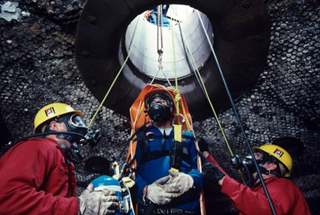Risk Analysis of Hot Working in Confined Space Using Confined Space Risk Analysis (CRSA) and Bowtie Analysis Method on LPG Tanker Repair Process
Main Article Content
Abstract
Confined space is a room that is large enough and has a configuration in such a way that workers can enter and do work in it. In the ship repair process it is not uncommon to do it in a confined space area. . The purpose of writing this final project is to identify hazards and carry out risk assessments in hot working in confined spaces in the LPG tanker ship repair process so that the dominant hazard is obtained, the causes and consequences of the dominant hazard are identified, and the right dominant risk control can be identified. This study begins with the identification of the characteristics of confined space on ships by grouping them into 7 risk categories of confined space. Then carry out risk identification by explaining the components of a risk, including: types of hazards, dangerous work, dangerous events and the consequences that can occur. After that, an initial risk assessment was carried out for hot working in confined spaces on ship repairs presented in matrix form. After that, risk control is carried out and the final risk reassessment for hot working in confined space on ship repair is carried out by continuing the matrix that was previously made. In the final stage, an analysis is carried out using the bowtie method to analyze the causes, impacts, and controls of these risks.
Downloads
Article Details

This work is licensed under a Creative Commons Attribution 4.0 International License.
References
H. Palippui and S. Ramadhan, “Analysis of The Strength of Barge Structures in the Load Out Offshore Module (Top Side) Process with SPMT”, zonalaut, vol. 1, no. 1, pp. 1-5, Mar. 2020.
A. Ma’ruf, D. Paroka, and H. Palippui, “Analysis Of The Influence Of Total Content On Tank Sloshing Load On Tanker Vessels Using Numeric Method”, zonalaut, vol. 2, no. 1, pp. 7-13, Mar. 2021.
Occupational Safety and Health Administration (OSHA) 3138-01R: Permit-Required Confined Spaces. US Department of Labor, 2004.
International Maritime Organization (IMO) A. 1050: Recommendations for Entering Enclosed Spaces Aboard Ship. London, UK, 2011.
International Labour Organization (ILO). Safety and Health in Shipbuilding and Ship Repair. Geneva, Switzerland, 2019
Occupational Safety and Health Administration (OSHA): Hot Work (Including Welding, Cutting, and Heating). US Department of Labor, 2017.
Pritchard, Carl L., and PMI-RMP PMP. Risk management: concepts and guidance. Auerbach Publications, 2014.
Burlet-Vienney, Damien., dkk. The Need for a Comprehensive Approach to Managing Confined Space Entry: Summary of the Literature and Recommendations for Next Steps. Journal of Occupational and Environmental Hygiene, Vol. 11, No. 8, pp.485- 498, Institut de recherche Robert-Sauvé en santé et en sécurité du travail, Kanada, 2014.
Benini, Aldo., dkk. The Use of Expert Judgement in Humanitarian Analysis - Theory, Methods and Apllications. ACAPS. Geneva,Switzerland, 2017.
Chinniah, Yuvin., dkk. Development of a Confined Space Risk Analysis and Work Categorization Tool. Studies and Research Projects, R-955. Institut de recherche Robert-Sauvé en santé et en sécurité du travail, Kanada, 2017.
Burlet-Vienney, Damien, et al. "Design and application of a 5 step risk assessment tool for confined space entries." Safety science 80 (2015): 144-155.
Burlet-Vienney, Damien, et al. "Risk analysis for confined space entries: Critical analysis of four tools applied to three risk scenarios." Journal of occupational and environmental hygiene 13.6 (2016): D99-D108.
Botti, Lucia., dkk. A Methodology for the Identification of Confined Spaces in Industry : A Survey. Journal of Occupational and Environmental Hygiene, Vol. 14, No. 4, pp. 271-284. Taylor & Francis, UK, 2018.
Saud, Yaneira E., dkk. Bow-Tie Diagrams in Downstream Hazard Identification and Risk Assessment. Process Safety Progress, Vol. 33, No.1, pp. 26-35, American Institute of Chemical Engineers (AIChE), NewYork,2013

